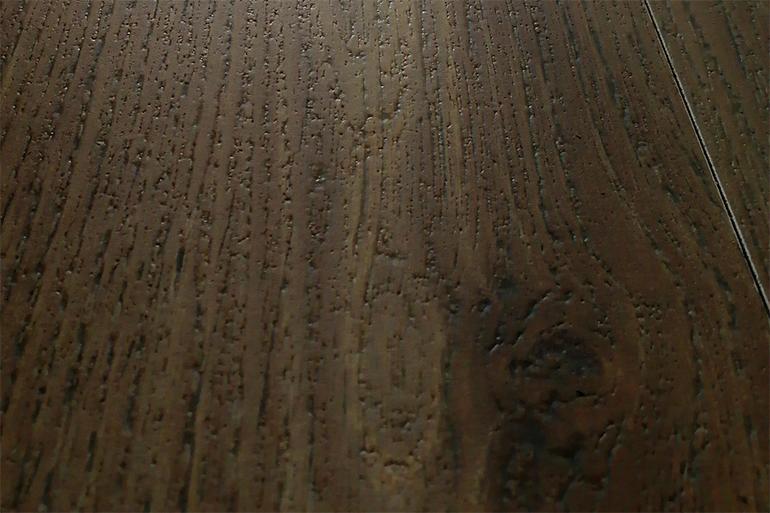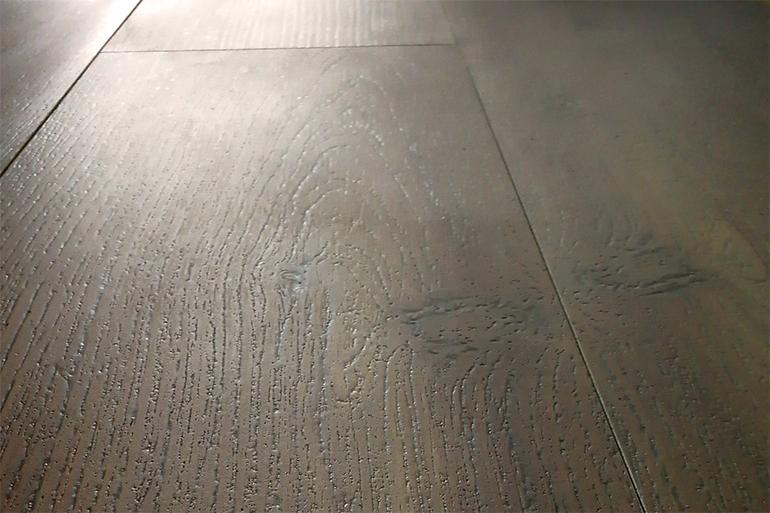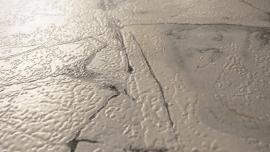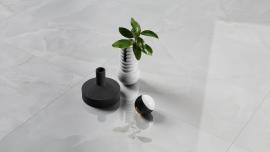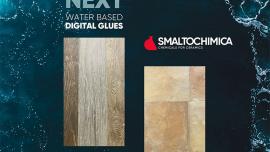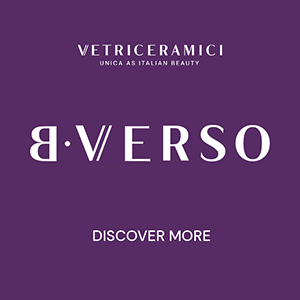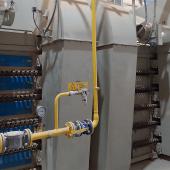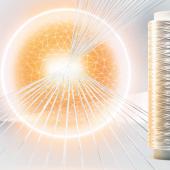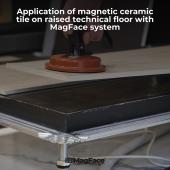Flow: the present and future of digital glaze and grit application
In recent years, part of Smaltochimcia’s research has focused on the digitalisation of the ceramic tile glazing process, through the development of materials and additives that can be used either with piezoelectric printheads or with “digital glaze coaters”.
By Marzia Barattini (Smaltochimica)
Smaltochimica is a company specialising in the production of additives and inks for digital printing, with a product range that spans all stages of the ceramic tile production cycle. In recent years, part of its research has focused on the digitalisation of the glazing process, namely all the operations involved in forming the glassy layer on the surface of a ceramic tile, including engobes, glazes and grits.
This vitreous layer serves a dual purpose: one is a protective function (making the tile waterproof, cleanable and durable), the other prevalently aesthetic in nature. The majority of these operations are still carried out using traditional analogue techniques, although intense efforts are being made to digitalise this stage as well. Current research is focused on two main technologies: piezoelectric printheads (borrowed from digital decoration) and a series of machines that can be described as “digital glaze coaters”.

Piezoelectric printheads
Although this technology is now widely adopted for digital decoration, it still presents certain challenges that restrict its use in the field of glazing. Extremely fine grain sizes and limited application volumes affect the reactivity of the components, while the performance of the fired product may be inferior to that achieved with traditional techniques, especially in terms of abrasion and chemical resistance. Moreover, despite the use of water-based formulations, emissions during firing can remain high due to the breakdown of organic additives present in the mix.
So while this remains a very promising technology, its application has not yet been fully optimised for all uses.
Digital glues for grits
The digital application of grits is now a well-established and widely used technology. Smaltochimica was one of the first companies to develop materials for this process and today offers an extensive line of digital binders called Digicol. These products stand out for their strong bonding capacity, long drying times, broad range of surface finishes and excellent graphic definition. They are compatible with both traditional machines and standalone units with integrated grit applicators.
The Digicol series is divided into three subgroups, each with a different liquid-phase chemistry tailored to a variety of production needs:
- Digicol Plus: extremely easy to use, with very long drying times and the availability of numerous material effects;
- Digicol Pure: also approved for use with all commercial printheads and formulated above all to minimise odorous emissions;
- Digicol Next: with their high water content, these products significantly reduce carbon, aldehyde and odour emissions, but require compatible printheads and regular maintenance. They are suitable for use with standard digital inks and offer excellent discharge and adhesion characteristics.
Digital glaze coaters
Digital glaze coaters are a diverse family of systems capable of depositing traditional ceramic slips on demand. Exploiting a variety of feeding and application mechanisms, they deposit a sequence of precisely sized droplets that coalesce on the tile surface to form a continuous, uniform layer.
Their main advantage is that they represent a way of digitalising the process, allowing for increased flexibility, reduced material use, less waste, lower water consumption and a healthier working environment. Moreover, they apply materials with highly standardised grain sizes and application weights, so final performance after firing is equivalent to that achieved using conventional glazing techniques.
Of course, there are limitations. Difficulties tend to occur at lower application weights, while the characteristic application pattern or texture must be carefully managed. Here, the role of additives becomes crucial.
The ideal additives and the Flow series
The rheological behaviour of the ceramic suspension and consequently the correct use of additives is key to the effective operation of digital glaze coaters.
In the development phase, an in-depth understanding of the composition of the ceramic suspension must be accompanied by detailed analysis using a rotational rheometer. While behaviour at low shear rates (in minimal stress conditions) determines printing pressure resistance and the characteristics of the suspension, the behaviour at high shear rates (under dynamic stress) simulates the conditions experienced during printing and recirculation.
Measuring solely the Ford viscosity cup efflux time, a method still widely used for quick process control, often leads to misleading or incomplete results.
Digital glaze coaters are also used for the wet application of grits, with extremely promising results. Compared to conventional systems such as airless, curtain coaters or bells, the main difference lies in the finer grain size, which helps prevent abrasion inside circuits and dispensers. The so-called nanogrits with extremely fine and controlled particle sizes (generally under 70-80 microns) still deliver good technical properties and a wide variety of surface effects.
For both glazes and suspended grits, the use of properly formulated additives is essential to achieve uniform, high-quality deposition.
Ideally, additives are complex formulations that perform numerous functions:
- binding, to ensure a compact and durable layer;
- suspension-forming, to prevent sedimentation;
- lubricating, to keep the product efficient during recirculation and regulate drying, promoting the formation of a cohesive layer;
- levelling, to improve surface finish and enhance film uniformity;
- anti-foaming, to prevent the formation of foam during mixing, loading and glazing machine operation and avoid application defects deriving from the formation of bubbles.
Smaltochimica’s R&D and Customer Service teams have developed dedicated products for use with digital glaze coaters. The FLOWJET series for engobes and glazes and the GRANICOL FLOW line for wet application of microgrits are valid solutions to widely varying production requirements while guaranteeing excellent technical characteristics and process continuity.
Conclusions
The digitalisation of glazing remains an ongoing, evolving process. Additives and an in-depth knowledge of material rheology play a vital role in successful product development.
The ceramic production process faces constant challenges in terms of the variety of materials and specific operating conditions involved. There are no universal solutions, so companies have to pursue a tailored approach involving close cooperation between all players in the supply chain.
As the long-established hub of ceramic innovation, Sassuolo continues to be the ideal location for pursuing this evolution.
Did you find this article useful?
Join the CWW community to receive the most important news from the global ceramic industry every two weeks



